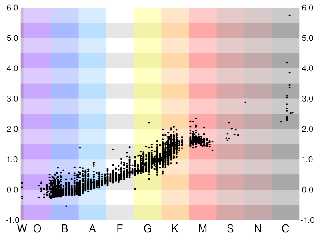Christian Froeschlin <chr### [at] chrfr de> wrote:
> Cousin Ricky wrote:
>
> > The coolest star in the BSC4 has a B-V of 5.74, and is type C6IIe. (A carbon
> > star would screw up the black body correlation, wouldn't it?) I don't know if
> > all the high B-V stars are carbon stars. Also, I don't know what a carbon star
> > looks like.
>
> Ah, you are of course correct. For more exotic spectral classes,
> where the color of the star is not dominated by a blackbody spectrum,
> you can easily get B-V outside the common "temperature" range. In the
> case of carbon stars the abundant carbon in the atmosphere of the star
> absorbs much of the blue light that would otherwise be emitted.
>
> To really be certain about this you need to have a spectrum of
> the star so you know the spectral class. That information is much
> less readily available. About 300K+ stars with known spectrum are
> in http://en.wikipedia.org/wiki/Henry_Draper_Catalogue. On the
> other hand, if you see a star with B-V > 2.0 it's probably a
> good bet that you shouldn't interpret this as temperature.
Attached is a plot of B-V color index against spectral class, using BSC4 data.
I omitted objects with no color index and stars whose spectral data I could not
make sense of. de> wrote:
> Cousin Ricky wrote:
>
> > The coolest star in the BSC4 has a B-V of 5.74, and is type C6IIe. (A carbon
> > star would screw up the black body correlation, wouldn't it?) I don't know if
> > all the high B-V stars are carbon stars. Also, I don't know what a carbon star
> > looks like.
>
> Ah, you are of course correct. For more exotic spectral classes,
> where the color of the star is not dominated by a blackbody spectrum,
> you can easily get B-V outside the common "temperature" range. In the
> case of carbon stars the abundant carbon in the atmosphere of the star
> absorbs much of the blue light that would otherwise be emitted.
>
> To really be certain about this you need to have a spectrum of
> the star so you know the spectral class. That information is much
> less readily available. About 300K+ stars with known spectrum are
> in http://en.wikipedia.org/wiki/Henry_Draper_Catalogue. On the
> other hand, if you see a star with B-V > 2.0 it's probably a
> good bet that you shouldn't interpret this as temperature.
Attached is a plot of B-V color index against spectral class, using BSC4 data.
I omitted objects with no color index and stars whose spectral data I could not
make sense of.
Post a reply to this message
Attachments:
Download 'bsc4_colors.png' (60 KB)
Preview of image 'bsc4_colors.png'

|




![]()